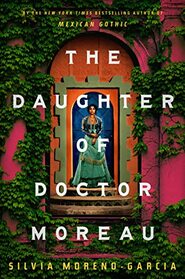Shaking Up the Island
Silvia Moreno-Garcia is a wizard... or just an incredibly gifted writer unrestrained by literary genre. Her most well known novel, "Mexican Gothic," strikes its note in the horror genre, "Velvet Was the Night" is historic fiction and noir, while "The Daughter of Doctor Moreau" has taken the science fiction outline of H. G. Wells' "The Island of Doctor Moreau" and retools it with a fusion of modern themes.
During the 1870's in a remote spot in Mexico's Yucatan peninsula, Doctor Moreau and his beautiful daughter Carlota run a secret sanitarium. The patients are unusual, creations of the doctor himself, they are part human, part animal hybrids. This operation is funded by a wealthy landowner, Hernando Lizalde, whose primary interest is finding a source of cheap labor. Traditional slavery is gone, the indigenous population is rebellious, and importing Chinese or European labor has become costly. Doctor Moreau's labor force will be Lizalde's to own, unconditionally.
The Doctor takes great pride in his early results, fantasizing about accolades awaiting him during a fanciful European tour. He has given the world life forms which have never existed. He also has a controlling power over these hybrids. They are dependent on him for life-sustaining injections containing a formula he keeps secret.
Carlota is the dominant voice of this story. A devoted daughter, she feels herself being pulled apart as she perceives her father's callousness to the creatures he has produced. It dawns on her that he has been needlessly cruel:
'He shaped pain into flesh." She feels a responsibility to assume control at the same time she is being pressured into a future she has no control over.
The third main character, Montgomery Laughton, is recruited to oversee the operation of the residence, the post of mayordomo. He is a disillusioned wanderer, burned by love and fueled at this point by alcohol. After an initial shock he befriends the hybrids and finds himself adjusting well to his position and the relative anonymity it provides. He is significantly older than Carlota and strong protective feelings emerge-- as well as a physical attraction he understands would be doomed by the age difference.
This paradise starts to unravel as Doctor Moreau's results are not paying off satisfactorily for his investor. Then, as now, the world demands support from the cheapest labor pool. Business demands results. Morality and ethical questions are insignificant when faced with the bottom line.
"The Daughter of Doctor Moreau" is an intoxicating read, transporting us to another time and place in history. The various movie treatments of the H. G. Wells original bring expectations of ridiculous-looking special effect creatures. Here the written word mixes with the imagination to provide stronger images and to enhance the enjoyment rather than spoiling it.
I received an advance review copy for free, and I am leaving this review voluntarily.
Silvia Moreno-Garcia is a wizard... or just an incredibly gifted writer unrestrained by literary genre. Her most well known novel, "Mexican Gothic," strikes its note in the horror genre, "Velvet Was the Night" is historic fiction and noir, while "The Daughter of Doctor Moreau" has taken the science fiction outline of H. G. Wells' "The Island of Doctor Moreau" and retools it with a fusion of modern themes.
During the 1870's in a remote spot in Mexico's Yucatan peninsula, Doctor Moreau and his beautiful daughter Carlota run a secret sanitarium. The patients are unusual, creations of the doctor himself, they are part human, part animal hybrids. This operation is funded by a wealthy landowner, Hernando Lizalde, whose primary interest is finding a source of cheap labor. Traditional slavery is gone, the indigenous population is rebellious, and importing Chinese or European labor has become costly. Doctor Moreau's labor force will be Lizalde's to own, unconditionally.
The Doctor takes great pride in his early results, fantasizing about accolades awaiting him during a fanciful European tour. He has given the world life forms which have never existed. He also has a controlling power over these hybrids. They are dependent on him for life-sustaining injections containing a formula he keeps secret.
Carlota is the dominant voice of this story. A devoted daughter, she feels herself being pulled apart as she perceives her father's callousness to the creatures he has produced. It dawns on her that he has been needlessly cruel:
'He shaped pain into flesh." She feels a responsibility to assume control at the same time she is being pressured into a future she has no control over.
The third main character, Montgomery Laughton, is recruited to oversee the operation of the residence, the post of mayordomo. He is a disillusioned wanderer, burned by love and fueled at this point by alcohol. After an initial shock he befriends the hybrids and finds himself adjusting well to his position and the relative anonymity it provides. He is significantly older than Carlota and strong protective feelings emerge-- as well as a physical attraction he understands would be doomed by the age difference.
This paradise starts to unravel as Doctor Moreau's results are not paying off satisfactorily for his investor. Then, as now, the world demands support from the cheapest labor pool. Business demands results. Morality and ethical questions are insignificant when faced with the bottom line.
"The Daughter of Doctor Moreau" is an intoxicating read, transporting us to another time and place in history. The various movie treatments of the H. G. Wells original bring expectations of ridiculous-looking special effect creatures. Here the written word mixes with the imagination to provide stronger images and to enhance the enjoyment rather than spoiling it.
I received an advance review copy for free, and I am leaving this review voluntarily.
Moreno-Garcia once again sets a lovely, ominous, atmospheric scene. See my full review in the September 2023 PBS Blog.




